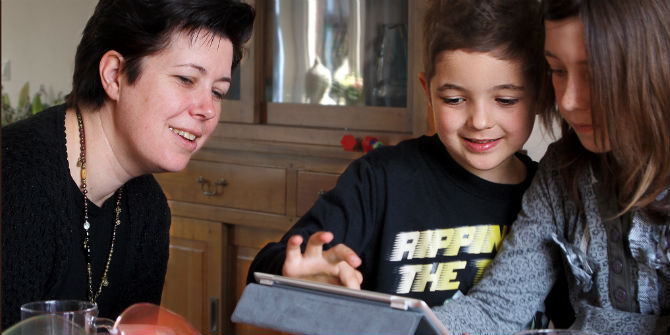 Earlier this year the UK government Department for Digital, Culture, Media and Sport published an ‘Online Media Literacy Strategy,’ as promised in the online harms white paper. In this blog, LSE’s Professor Sonia Livingstone explains here why the strategy represents a missed opportunity to move beyond a preoccupation with online safety to truly develop the public’s media literacy. In a recent talk to mark UNESCO’s Global Media and Information Literacy Week, Prof Livingstone set out how media literacy must serve citizens as well as consumers.
Earlier this year the UK government Department for Digital, Culture, Media and Sport published an ‘Online Media Literacy Strategy,’ as promised in the online harms white paper. In this blog, LSE’s Professor Sonia Livingstone explains here why the strategy represents a missed opportunity to move beyond a preoccupation with online safety to truly develop the public’s media literacy. In a recent talk to mark UNESCO’s Global Media and Information Literacy Week, Prof Livingstone set out how media literacy must serve citizens as well as consumers.
The UK government’s long-promised national media literacy strategy was released this summer. You could be forgiven if you missed it, for it has received a lukewarm welcome at best, except from those – such as the News Literacy Network – that supported its development.
My welcome is equally lukewarm. There’s plenty of positive suggestions in this detailed and well-meaning strategy, and if everything promised in it came to pass, the problem of disinformation would likely be alleviated. But not by much, I suggest, for most of the suggestions paper over the cracks of the information crisis and its five evils of confusion, cynicism, fragmentation, irresponsibility and apathy.
It’s an opportunity missed, being less a strategy and more a shopping list of useful actions that, like most shopping lists, mirrors what’s gone before without charting new directions. As a shopping list it certainly has merit, highlighting six barriers to be overcome if the government is to improve the nation’s online media literacy:
- Evaluation – it’s important to know which initiatives work
- Funding – to follow through on long-term initiatives for sustained change
- Hard to reach audiences – to benefit all fairly, not just the already-engaged
- Vulnerable users – to overcome gaps in provision and ensure equity
- Audience resilience – to mitigate the harm of mis- and dis-information
- Coordination – among the UK’s 170+ organisations undertaking media literacy activity
All of these are indeed important. But are they enough? Part of the problem is that this strategy is linked to the Online Safety Bill. Consequently, it focuses on reducing consumer harms rather than addressing the breadth and depth of the media literacy agenda, further reducing the already-limited approach to media literacy required by the Communications Act 2003.
As Oliver Dowden, Secretary of State for Digital, Culture, Media, and Sport, explains in introducing the new strategy:
We want users to be able to critically evaluate the content they consume, understand that online actions can have offline consequences, and be able to contribute to a respectful and kind online environment.
We all want this, no doubt. However, it is hollow if not accompanied by the promotion of users’ other abilities, including to organise, protest, and ask difficult questions of those with power. In crucial ways, the online domain is today’s public sphere, and the strategy greatly undervalues citizens’ roles in critically evaluating, influencing and participating in digitally-mediated information and communication, instead limiting their contribution to the digital public sphere to that of “respectful and kind” consumers.
Not only does the strategy position the public as consumers rather than citizens, but it comes perilously close to blaming the user for the problems of the digital world. For instance, it observes that the majority of children who saw hateful content online “chose to ignore it” – even though plenty of research reveals that such a judgment neglects children’s own perspective. Indeed, children are frustrated that when they do report an online problem, nothing happens: to put it another way, it seems to children that platforms choose to ignore them. Adults, too, fear they won’t be taken seriously if they report online problems.
Overlooked in the strategy is the dependency of media literacy on the legibility of the digital environment. This is more than a matter of transparency, important though that is. For instance, the media literacy strategy specifies that media literate users” are able to control who has access to their data,” and expects businesses to “provide transparent and easily accessible information for users about where and how their data is being used on online platforms.” But there’s a gulf between users being able to access information about how their data is used and their capacity to control it, and this gulf is not to be bridged by educating users but, rather, by improving businesses offering them genuine choices about where and how their data is used. In practice, users are unlikely to learn much about the data ecology if they do not thereby gain greater choice or control. For the media literacy strategy to succeed, a systems-based approach towards internet regulation is necessary.
For the most part, the strategy’s expectations of business are limited to providing users with clearer cues, prompts and tools rather than preventing the problems occurring in the first place. But it does recognise “that users alone should not shoulder the responsibility of taking action to build their media literacy skills,” and to address this, it proposes “literacy by design.” For instance, businesses are not only expected to “provide guidance and support to users experiencing unwanted or hateful behaviour” but the strategy also observes that “exposure to misinformation and disinformation can be reduced by changes to algorithm design and content feeds.” Can? The strategy merely comments that “We are keen to see online platforms experiment with and implement literacy by design provisions which go beyond just tackling misinformation and disinformation.” The force behind this ‘keenness’ is unclear.
However, “by design” solutions are high on today’s agenda precisely as a means of preventing an unreasonable burden of responsibility falling on the shoulders of users and, instead, requiring system improvements from those with the power to make them. It will be important to ensure that the Online Safety Bill eases rather than compounds the media literacy burden on users, for instance by regulating the systems by which certain contents are amplified and targeted. Then perhaps we can move beyond today’s preoccupation with safety, important though it is. For it is also vital to promote and harness the public’s media literacy needed to achieve the many creative, educational, economic, civic, political and community goals of a fully functioning democracy in the digital age. Today’s information crisis has deep roots and will not be overcome by a strategy that limits its ambitions and those of the public.
Prof Sonia Livingstone: Media literacy strategy. Experience stories (a presentation at the conference Media literacy. Roadmaps.)
Notes
This text was originally published on the MediaLSE blog and has been re-posted with permission.
This post represents the views of the authors and not the position of the Parenting for a Digital Future blog, nor of the London School of Economics and Political Science.
You are free to republish the text of this article under Creative Commons licence crediting MediaLSE and the author of the piece. Please note that images are not included in this blanket licence.





